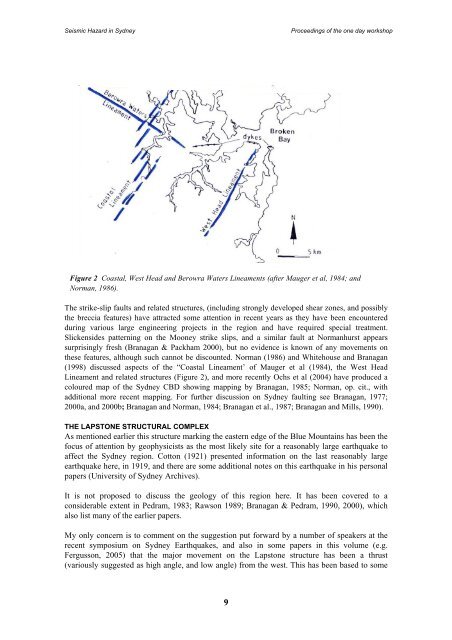Landslides in the Sydney Basin - Geoscience Australia
Landslides in the Sydney Basin - Geoscience Australia
Landslides in the Sydney Basin - Geoscience Australia
- No tags were found...
You also want an ePaper? Increase the reach of your titles
YUMPU automatically turns print PDFs into web optimized ePapers that Google loves.
Seismic Hazard <strong>in</strong> <strong>Sydney</strong>Proceed<strong>in</strong>gs of <strong>the</strong> one day workshopFigure 2 Coastal, West Head and Berowra Waters L<strong>in</strong>eaments (after Mauger et al, 1984; andNorman, 1986).The strike-slip faults and related structures, (<strong>in</strong>clud<strong>in</strong>g strongly developed shear zones, and possibly<strong>the</strong> breccia features) have attracted some attention <strong>in</strong> recent years as <strong>the</strong>y have been encountereddur<strong>in</strong>g various large eng<strong>in</strong>eer<strong>in</strong>g projects <strong>in</strong> <strong>the</strong> region and have required special treatment.Slickensides pattern<strong>in</strong>g on <strong>the</strong> Mooney strike slips, and a similar fault at Normanhurst appearssurpris<strong>in</strong>gly fresh (Branagan & Packham 2000), but no evidence is known of any movements on<strong>the</strong>se features, although such cannot be discounted. Norman (1986) and Whitehouse and Branagan(1998) discussed aspects of <strong>the</strong> “Coastal L<strong>in</strong>eament’ of Mauger et al (1984), <strong>the</strong> West HeadL<strong>in</strong>eament and related structures (Figure 2), and more recently Ochs et al (2004) have produced acoloured map of <strong>the</strong> <strong>Sydney</strong> CBD show<strong>in</strong>g mapp<strong>in</strong>g by Branagan, 1985; Norman, op. cit., withadditional more recent mapp<strong>in</strong>g. For fur<strong>the</strong>r discussion on <strong>Sydney</strong> fault<strong>in</strong>g see Branagan, 1977;2000a, and 2000b; Branagan and Norman, 1984; Branagan et al., 1987; Branagan and Mills, 1990).THE LAPSTONE STRUCTURAL COMPLEXAs mentioned earlier this structure mark<strong>in</strong>g <strong>the</strong> eastern edge of <strong>the</strong> Blue Mounta<strong>in</strong>s has been <strong>the</strong>focus of attention by geophysicists as <strong>the</strong> most likely site for a reasonably large earthquake toaffect <strong>the</strong> <strong>Sydney</strong> region. Cotton (1921) presented <strong>in</strong>formation on <strong>the</strong> last reasonably largeearthquake here, <strong>in</strong> 1919, and <strong>the</strong>re are some additional notes on this earthquake <strong>in</strong> his personalpapers (University of <strong>Sydney</strong> Archives).It is not proposed to discuss <strong>the</strong> geology of this region here. It has been covered to aconsiderable extent <strong>in</strong> Pedram, 1983; Rawson 1989; Branagan & Pedram, 1990, 2000), whichalso list many of <strong>the</strong> earlier papers.My only concern is to comment on <strong>the</strong> suggestion put forward by a number of speakers at <strong>the</strong>recent symposium on <strong>Sydney</strong> Earthquakes, and also <strong>in</strong> some papers <strong>in</strong> this volume (e.g.Fergusson, 2005) that <strong>the</strong> major movement on <strong>the</strong> Lapstone structure has been a thrust(variously suggested as high angle, and low angle) from <strong>the</strong> west. This has been based to some9
















